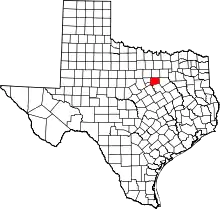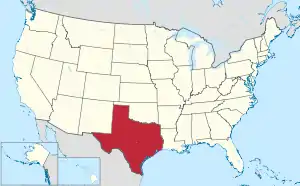Johnson County, Texas
Johnson County is a county located in the U.S. state of Texas. As of the 2020 census, its population was 179,927.[1] Its county seat is Cleburne.[2] Johnson County is named for Middleton Johnson, a Texas Ranger, soldier, and politician. Johnson County is included in the Dallas–Fort Worth–Arlington metropolitan statistical area.
Johnson County | |
|---|---|
.jpg.webp) | |
 Location within the U.S. state of Texas | |
 Texas's location within the U.S. | |
| Coordinates: 32°23′N 97°22′W | |
| Country | |
| State | |
| Founded | 1854 |
| Seat | Cleburne |
| Largest city | Burleson |
| Area | |
| • Total | 734 sq mi (1,900 km2) |
| • Land | 725 sq mi (1,880 km2) |
| • Water | 9.8 sq mi (25 km2) 1.3% |
| Population (2020) | |
| • Total | 179,927 |
| • Density | 245/sq mi (95/km2) |
| Time zone | UTC−6 (Central) |
| • Summer (DST) | UTC−5 (CDT) |
| Congressional district | 25th |
| Website | www |
History
The first settler of Johnson County was Henry Briden, who built a log cabin on the Nolan River in 1849.[3] His log cabin still exists, and can be seen along State Highway 174 in Rio Vista, Texas. The first county seat was Wardville, now located under the waters of Lake Pat Cleburne. In 1856, Buchanan became the county seat. Johnson County was divided in 1866, with the western half becoming Hood County. Camp Henderson became the new county seat and was renamed Cleburne in honor of Confederate General Patrick Cleburne.
Geography
According to the U.S. Census Bureau, the county has a total area of 734 square miles (1,900 km2), of which 725 square miles (1,880 km2) are land and 9.8 square miles (25 km2) (1.3%) are covered by water.[4]
Major highways
Adjacent counties
- Tarrant County (north)
- Dallas County (northeast)
- Ellis County (east)
- Hill County (south)
- Bosque County (southwest)
- Somervell County (southwest)
- Hood County (west)
- Parker County (northwest)
Communities
Cities (multiple counties)
- Burleson (small part in Tarrant County)
- Cresson (partly in Hood and Parker counties)
- Crowley (mostly in Tarrant County)
- Fort Worth (mostly in Tarrant County, with small parts in Denton, Parker, Wise, and Johnson counties)
- Mansfield (mostly in Tarrant County and a small part in Ellis County)
Cities
Towns
- Cross Timber
- Venus (small part in Ellis County)
Census-designated place
Demographics
| Census | Pop. | Note | %± |
|---|---|---|---|
| 1860 | 4,305 | — | |
| 1870 | 4,923 | 14.4% | |
| 1880 | 17,911 | 263.8% | |
| 1890 | 22,313 | 24.6% | |
| 1900 | 33,819 | 51.6% | |
| 1910 | 34,460 | 1.9% | |
| 1920 | 37,286 | 8.2% | |
| 1930 | 33,317 | −10.6% | |
| 1940 | 30,384 | −8.8% | |
| 1950 | 31,390 | 3.3% | |
| 1960 | 34,720 | 10.6% | |
| 1970 | 45,769 | 31.8% | |
| 1980 | 67,649 | 47.8% | |
| 1990 | 97,165 | 43.6% | |
| 2000 | 126,811 | 30.5% | |
| 2010 | 150,934 | 19.0% | |
| 2020 | 179,927 | 19.2% | |
| U.S. Decennial Census[5] 1850–2010[6] 2020[7] | |||
| Race / Ethnicity | Pop 2010[8] | Pop 2020[7] | % 2010 | % 2020 |
|---|---|---|---|---|
| White alone (NH) | 115,545 | 119,226 | 76.55% | 66.26% |
| Black or African American alone (NH) | 3,797 | 6,446 | 2.52% | 3.58% |
| Native American or Alaska Native alone (NH) | 741 | 840 | 0.49% | 0.47% |
| Asian alone (NH) | 951 | 1,726 | 0.63% | 0.96% |
| Pacific Islander alone (NH) | 475 | 929 | 0.31% | 0.52% |
| Some Other Race alone (NH) | 164 | 612 | 0.11% | 0.34% |
| Mixed Race/Multi-Racial (NH) | 1,942 | 7,535 | 1.29% | 4.19% |
| Hispanic or Latino (any race) | 27,319 | 42,613 | 18.10% | 23.68% |
| Total | 150,934 | 179,927 | 100.00% | 100.00% |
Note: the U.S. Census Bureau treats Hispanic/Latino as an ethnic category. This table excludes Latinos from the racial categories and assigns them to a separate category. Hispanics/Latinos can be of any race.
In 2000 there were 126,811 people, 43,636 households, and 34,428 families resided in the county.[9] The population density was 174 people per square mile (67 people/km2). The 46,269 housing units averaged 63 units per square mile (24/km2). In 2020, its population was 179,927, reflecting the increase of the Metroplex's population and suburbanization.
At the 2000 census, the racial makeup of the county was 90.01% White, 2.50% African American, 0.64% Native American, 0.52% Asian, 0.18% Pacific Islander, 4.52% from other races, and 1.63% from two or more races. About 12.12% of the population was Hispanic or Latino of any race. In 2010, its racial makeup was 76.55% non-Hispanic white, 2.52% African American, 0.47% Native American, 0.63% Asian American, 0.31% Pacific Islander, 0.11% some other race, 1.29% multiracial, and 18.10% Hispanic or Latino of any race.[8] By 2020, its racial and ethnic makeup was 66.26% non-Hispanic white, 3.58% African American, 0.47% Native American, 0.96% Asian, 0.52% Pacific Islander, 0.34% some other race, 4.19% multiracial, and 23.68% Hispanic or Latino of any race.[7]
As of 2000, the median income for a household in the county was $44,621, and for a family was $49,963. Males had a median income of $36,718 versus $25,149 for females. The per capita income for the county was $18,400. About 6.90% of families and 8.80% of the population were below the poverty line, including 10.60% of those under age 18 and 10.90% of those age 65 or over.
Education
School districts include:[10]
- Alvarado Independent School District
- Burleson Independent School District
- Cleburne Independent School District
- Crowley Independent School District
- Godley Independent School District
- Granbury Independent School District
- Grandview Independent School District
- Joshua Independent School District
- Keene Independent School District
- Mansfield Independent School District
- Rio Vista Independent School District
- Venus Independent School District
Hill College a college in Hillsboro, a town in neighboring Hill County also provides tertiary education, with a campus in Cleburne since 1971. Johnson County is defined by the Texas Education Code as being in the Hill College service area.[11]
Southwestern Adventist University, a private liberal arts university in Keene, is currently the only four-year institution of higher learning in Johnson County. Southwestern is affiliated with the Seventh-day Adventist Church and has existed since 1893.
Media
Johnson County is part of the Dallas/Fort Worth television media market in north-central Texas. Local news media outlets are: KDFW-TV, KXAS-TV, WFAA-TV, KTVT-TV, KERA-TV, KTXA-TV, KDFI-TV, KDAF-TV, KFWD-TV, and KDTX-TV. KCLE is the local radio station, which offers local news in addition to its country-music format. The local newspapers are the Cleburne Times-Review, Burleson Star, and Joshua Star.
Politics
| Year | Republican | Democratic | Third party | |||
|---|---|---|---|---|---|---|
| No. | % | No. | % | No. | % | |
| 2020 | 54,628 | 75.85% | 16,464 | 22.86% | 928 | 1.29% |
| 2016 | 44,382 | 77.04% | 10,988 | 19.07% | 2,236 | 3.88% |
| 2012 | 37,661 | 77.11% | 10,496 | 21.49% | 681 | 1.39% |
| 2008 | 36,685 | 73.30% | 12,912 | 25.80% | 453 | 0.91% |
| 2004 | 34,818 | 73.42% | 12,325 | 25.99% | 279 | 0.59% |
| 2000 | 26,202 | 67.66% | 11,778 | 30.41% | 746 | 1.93% |
| 1996 | 16,246 | 50.03% | 12,817 | 39.47% | 3,410 | 10.50% |
| 1992 | 13,473 | 36.22% | 12,030 | 32.34% | 11,699 | 31.45% |
| 1988 | 17,509 | 58.03% | 12,507 | 41.45% | 155 | 0.51% |
| 1984 | 18,254 | 66.44% | 9,148 | 33.30% | 72 | 0.26% |
| 1980 | 11,411 | 50.82% | 10,542 | 46.95% | 501 | 2.23% |
| 1976 | 7,194 | 39.69% | 10,864 | 59.93% | 69 | 0.38% |
| 1972 | 10,042 | 71.04% | 3,968 | 28.07% | 126 | 0.89% |
| 1968 | 4,372 | 35.23% | 5,330 | 42.95% | 2,709 | 21.83% |
| 1964 | 3,251 | 33.72% | 6,381 | 66.18% | 10 | 0.10% |
| 1960 | 4,510 | 53.49% | 3,844 | 45.59% | 77 | 0.91% |
| 1956 | 3,750 | 51.09% | 3,560 | 48.50% | 30 | 0.41% |
| 1952 | 3,985 | 46.97% | 4,496 | 52.99% | 4 | 0.05% |
| 1948 | 707 | 13.59% | 4,042 | 77.70% | 453 | 8.71% |
| 1944 | 546 | 9.26% | 4,757 | 80.68% | 593 | 10.06% |
| 1940 | 649 | 10.50% | 5,532 | 89.47% | 2 | 0.03% |
| 1936 | 337 | 7.25% | 4,281 | 92.12% | 29 | 0.62% |
| 1932 | 530 | 9.81% | 4,858 | 89.88% | 17 | 0.31% |
| 1928 | 3,181 | 61.58% | 1,981 | 38.35% | 4 | 0.08% |
| 1924 | 851 | 14.77% | 4,600 | 79.85% | 310 | 5.38% |
| 1920 | 661 | 15.65% | 3,041 | 71.99% | 522 | 12.36% |
| 1916 | 275 | 7.86% | 3,040 | 86.93% | 182 | 5.20% |
| 1912 | 109 | 3.56% | 2,473 | 80.84% | 477 | 15.59% |
See also
- Johnson County Courthouse
- List of museums in North Texas
- National Register of Historic Places listings in Johnson County, Texas
- Recorded Texas Historic Landmarks in Johnson County
- DeWayne Burns, state representative from Johnson and Bosque counties, effective 2015
References
- "Johnson County, Texas". United States Census Bureau. Retrieved January 30, 2022.
- "Find a County". National Association of Counties. Archived from the original on May 31, 2011. Retrieved June 7, 2011.
- Elam, Richard. "Johnson County". Handbook of Texas Online. Texas State Historical Association. Retrieved December 30, 2020.
- "2010 Census Gazetteer Files". United States Census Bureau. August 22, 2012. Archived from the original on April 19, 2015. Retrieved May 2, 2015.
- "Decennial Census of Population and Housing by Decades". US Census Bureau.
- "Texas Almanac: Population History of Counties from 1850–2010" (PDF). Texas Almanac. Archived (PDF) from the original on February 26, 2015. Retrieved May 2, 2015.
- "P2 HISPANIC OR LATINO, AND NOT HISPANIC OR LATINO BY RACE - 2020: DEC Redistricting Data (PL 94-171) - Johnson County, Texas". United States Census Bureau.
- "P2 HISPANIC OR LATINO, AND NOT HISPANIC OR LATINO BY RACE - 2010: DEC Redistricting Data (PL 94-171) - Johnson County, Texas". United States Census Bureau.
- "U.S. Census website". United States Census Bureau. Retrieved May 14, 2011.
- "2020 CENSUS - SCHOOL DISTRICT REFERENCE MAP: Johnson County, TX" (PDF). U.S. Census Bureau. Archived (PDF) from the original on October 9, 2022. Retrieved June 30, 2022. - Text list
- Texas Education Code, Sec. 130.181. HILL COLLEGE DISTRICT SERVICE AREA.
- Leip, David. "Dave Leip's Atlas of U.S. Presidential Elections". uselectionatlas.org. Archived from the original on March 23, 2018. Retrieved May 7, 2018.
External links
![]() Media related to Johnson County, Texas at Wikimedia Commons
Media related to Johnson County, Texas at Wikimedia Commons